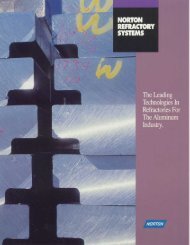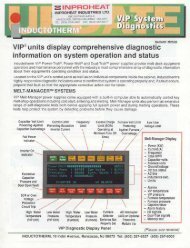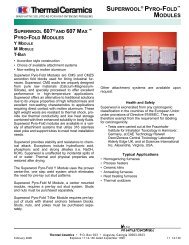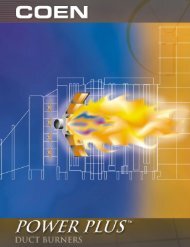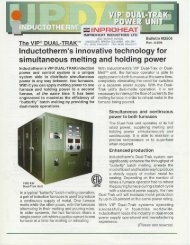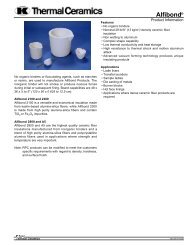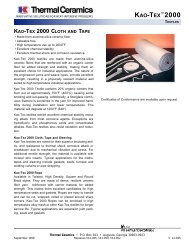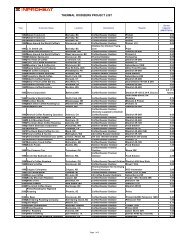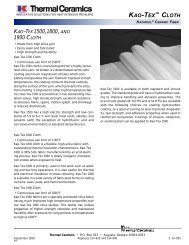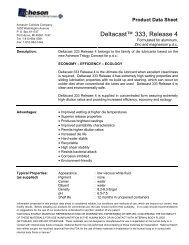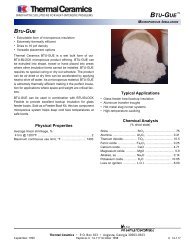Coen Development of a High Performance Versatile Low ... - Inproheat
Coen Development of a High Performance Versatile Low ... - Inproheat
Coen Development of a High Performance Versatile Low ... - Inproheat
You also want an ePaper? Increase the reach of your titles
YUMPU automatically turns print PDFs into web optimized ePapers that Google loves.
Presented at 1996 AFRC International Symposium, Baltimore, Maryland, September 1996<strong>Development</strong> <strong>of</strong> a <strong>High</strong> <strong>Performance</strong><strong>Versatile</strong> <strong>Low</strong> NOx BurnerVladimir Lifshits<strong>Coen</strong>, Inc.1510 Rollins Road, Burlingame, CA 94010ABSTRACTThe paper describes the development process <strong>of</strong> a new <strong>Coen</strong> low NOx high performanceburners and the transition from a successfully tested prototype to a commercially availableproduct . The performance data are illustrated by the results achieved at the test facility and innumerous package and field erected boilers. The burner was the first commercial product thatcould fire Natural Gas with NOx emissions below 30 ppm and low carbon monoxide emissionswithout the use <strong>of</strong> flue gas recirculation (FGR) in a wide variety <strong>of</strong> package boilers. For theboilers with low space heat release rates the burner achieves even lower NOx in the range 15-20ppm.The burner is specifically suited for industrial duty applications, as it does not impose any specialrequirements to the control system, like tight air fuel ratio, O2 trim, etc. The burner achieves 10to 1 turn down and with some modifications allows turn down in the excess <strong>of</strong> 15 to 1. Theburner can easily fire other gaseous fuels like refinery gas and does not require special gaspreparation, as the typical minimum diameter for the gas discharge is more than 1/8”. Theversatility <strong>of</strong> the burner is also enhanced by its ability to operate with induced or selective FGRas it allows NOx reduction down to the 12-15 ppm level.While most <strong>of</strong> the burner performance can be realized when firing gaseous fuel, liquid fuels like#2 and #6 oil can also be fired separately or simultaneously with gas. Change over between fuelcan be done on line.INTRODUCTIONThe development <strong>of</strong> this new low emission burner was prompted by new regulations requiringlower and lower NOx emission standards country wide. Until recently the only practical way toreduce NOx emissions from packaged boiler firing Natural Gas to the level <strong>of</strong> 30 ppm was tooperate with a significant amount <strong>of</strong> FGR, that was resulting in an increase in capital andoperational cost and in some instances reduction in the boiler efficiency, and capacity.This paper describes the development <strong>of</strong> a new type <strong>of</strong> burner that achieves 60-80% NOxreduction, when firing gaseous fuels, and 20-30% lower emissions, when firing oil without usingFGR. The burner was developed in various modifications that together comprise a unique class<strong>of</strong> fuel staged burners with one specific feature in common: combustion air and primary gaseousfuel are rapidly mixed together and discharged into the furnace through a series <strong>of</strong> radial slots.The trade name <strong>of</strong> these class <strong>of</strong> burners is QLN. The primarily applications for QLN burnersare retr<strong>of</strong>it and OEM markets <strong>of</strong> packaged and field erected boilers.The development <strong>of</strong> the burner was launched in late 1992. In 1993 numerous 40 and 50MMBtu/Hr prototypes were extensively tested at the <strong>Coen</strong> company test facility. The firstintroduction to the market was in early 1994, when a 75,000pph B&W packaged boiler wasretr<strong>of</strong>itted with model QLN-3.4, firing natural gas or jet fuel without the use <strong>of</strong> FGR. In this boilerthe burner demonstrated less than 30 ppm NOx on gas. During 1994 and 1995 the developmentcontinued. The burners were designed and built in different sizes with the capacity ranging from20 to 200 MMBtu/Hr. Modifications <strong>of</strong> the burner were developed to accommodate numerousspecific applications: refinery gas type fuels, high combustion air temperature, selective FGR,extremely short furnaces. The result was an array <strong>of</strong> QLN burner designs that could be applied
for a wide variety <strong>of</strong> packaged and field erected boilers. By the end <strong>of</strong> 1995 there were over 100burners operating in the United States and some in Europe.QLN BURNER. PRINCIPLE OF OPERATIONThere are three main mechanisms <strong>of</strong> NOx formation that have been extensively described in theliterature: prompt NOx , thermal NOx and NOx originated from nitrogen content species in thefuel (fuel bound nitrogen). Formation <strong>of</strong> prompt NOx can be greatly reduced if the fuel burnsunder fuel lean conditions. Formation <strong>of</strong> thermal NOx is an exponential function <strong>of</strong> peak flametemperature and can be reduced, if the combustion region contains high amount <strong>of</strong> combustionproducts with temperatures much lower than the adiabatic flame, or again under fuel leanconditions when excess <strong>of</strong> air serves as a diluent. Formation <strong>of</strong> NOx from nitrogen in the fuel istypically a concern only when firing oil, as gaseous fuels seldom contain non molecular nitrogencomponents. Fuel rich environment is beneficial for the reduction <strong>of</strong> this source <strong>of</strong> NOx.QLN burners effectively reduce formation <strong>of</strong> NOx from all there sources.The basic burner design is shown on Fig.1. The main burner parts are primary, secondary andcore gas headers with gas spuds that provide distribution <strong>of</strong> gaseous fuel. The burner body withthe attached air distribution plate shapes air flow into a star pattern. The primary gas is injectedinto the air flow inside the burner through the radial spuds, so most <strong>of</strong> the mixing <strong>of</strong> gas and air istaking place upstream <strong>of</strong> the distribution plate. The axial part <strong>of</strong> the burner is reserved for the oilgun. The core gas header is typically positioned around the oil gun guide pipe. The burner isequipped with a short straight throat. The secondary gas spuds protrude through the ports in thethroat. When firing oil, these ports are used for bringing a portion <strong>of</strong> air into the combustionarea. A simple mechanism allows for closing or opening <strong>of</strong> all the ports at once. The sameports are sometimes used as the injection points for the flue gas recirculation, if broughtselectively to the burner.Figure 1. Basic QLN BurnerThe flame structure <strong>of</strong> a QLN burner firing gaseous fuels is extremely complex and to somedegree depends on the adjustments made to the burner. Typically the combustion process withQLN burners can be described as follows.2
The mixture <strong>of</strong> primary gas and air is very lean. This mixture gradually burners in the furnace asit mixes with combustion products <strong>of</strong> the core, hot furnace gases and secondary fuel. Thiscombustion process is mostly taking place at the lean limits <strong>of</strong> flammability, thus formation <strong>of</strong> bothprompt and thermal NOx are greatly reduced.The secondary fuel ignition point is also delayed as the furnace gases in the area around theburner has very low oxygen content. Gradual burning starts as the secondary fuel engagesoxygen from the combustion air both prior and after the combustion <strong>of</strong> primary gas.The core fuel is a small percentage <strong>of</strong> the overall fuel flow. It provides a reliable ignition sourcefor the primary and secondary fuel.An overall interleaving pattern <strong>of</strong> air and fuel distribution creates conditions for a sufficientlycompact overall flame and low carbon monoxide emissions with low excess air.As the mixing <strong>of</strong> primary gas and air takes place inside the burner, flash back can happen at lowloads. This problem was addressed during the early development stage by simply allowing flashback to occur. This typically happens with one or two slots <strong>of</strong> air and primary gas flow at theloads below 20%. At these reduced loads flash back is continuous, but does not cause anydamage to the burner. Each small flash back flame is surrounded by considerable amount <strong>of</strong>combustion air and is not in contact with the burner parts. The overall turn down <strong>of</strong> the burner is1.2 to 1.3 times <strong>of</strong> the turn down in the combustion air flow. Typically turn down <strong>of</strong> 8:1 to 10:1can be met with the basic QLN design without a significant increase in CO emissions. Forspecial applications requiring wider turn downs a special modified QLN burner was developedthat is capable <strong>of</strong> a turn down up to 2.5 times that <strong>of</strong> the turn down <strong>of</strong> the combustion air. Withthe adequate fuel controls this easily translates into the burner turn downs over 15:1. This higherturn down modification, however, shows slightly higher NOx.The above description is based on the observations <strong>of</strong> the flame patterns generated by burners<strong>of</strong> different sizes operating under different conditions. CFD modeling was only moderatelyused in the burner design, as accurate predictions <strong>of</strong> ignition points flame fronts, etc. are stillvery difficult and not reliable for this complex three dimensional problem even with modern CFDcodes like Fluent. Some useful results came from the mixing model between primary gas andair that helped in the optimization process. Most <strong>of</strong> the work, however, was done experimentally.The burner also shows good NOx performance when firing oil. This is attributed to the effect <strong>of</strong>enhanced recirculation <strong>of</strong> combustion products in the part <strong>of</strong> the furnace adjacent to the burnerand the effect <strong>of</strong> air staging. As the major portion <strong>of</strong> combustion air discharges into the furnacein a spoke star shaped pattern the entrainment <strong>of</strong> rate <strong>of</strong> furnace gas by combustion air is greatlyenhanced, if compared with the entrainment by a single round jet. This creates reduction in theflame temperature and reduced thermal NOx production. At the same time, diverting a certainportion <strong>of</strong> air flow to the ports around the burner throat creates air staged combustion, when most<strong>of</strong> the fuel burns in reduced oxygen environment, thus reducing NOx formation from fuel boundnitrogen as well as thermal NOx.BURNER PERFORMANCE AND OPERATING PARAMETERSThe first prototype <strong>of</strong> the burner was built with the throat diameter <strong>of</strong> 20”. The second prototypehad 26” diameter throat and was rated to 60 MMBtu/Hr. Test firings were performed in an eightfeet diameter water cooled furnace partially lined with refractory. The furnace had numerousobservation ports and ports for the flue gas sampling. The very first prototypes <strong>of</strong> the burner hadlimited stability range with respect to variations in the excess air. After the improvements to thedesign, however, combustion stability was reliably maintained up to 9-10% O2.The test data shown in Fig. 2 were plotted versus excess air as it appeared to be the mainparameter determining the NOx for any given burner modification within the wide range <strong>of</strong> loads.The effect <strong>of</strong> firing rate on NOx in the test furnace was relatively small. The deviation <strong>of</strong> data isprimarily due to different burner adjustments.The size <strong>of</strong> the visual flame body and CO emissions measured with a traversing probe atdifferent distances from the furnace front were also a strong function <strong>of</strong> the overall excess air. At3
3% O2 in the flue gas for example the combustion was practically complete within the volumecorresponding to the combustion intensity about 75-80 kBtu/ft3. When testing modifications <strong>of</strong>the burner designed to higher flame intensity (smaller flame diameter) NOx emissions wereinevitably higher.To be able to apply QLN burners to short boilers a version <strong>of</strong> QLN, called QLN/S (where “S”stands for “swirl”) was developed. The flame was shortened and widened without any penaltieson the NOx emission side.Interesting results were achieved when operating with preheated air.. The initial data showed thatthe function <strong>of</strong> percentage <strong>of</strong> NOx increase with air temperature was practically identical to aconventional burner without staged combustion. However, with an adjustment was made to thefuel distribution, the rate <strong>of</strong> NOx increase was much slower, Fig. 3. This means that optimumsettings <strong>of</strong> the fuel distribution is a function <strong>of</strong> air temperature.The burner was also tested when operating with the flue gas bulk mixed with the combustion airand with the flue gas introduced into the furnace through the ports surrounding the secondarygas spuds separately from the combustion air. In the case <strong>of</strong> bulk mixed flue gas, thedistribution <strong>of</strong> fuel had to be shifted to the primary gas and the effectiveness <strong>of</strong> flue gas on apercentage basis was slightly less, if compared with FGR brought selectively, Fig. 4. With eithertype <strong>of</strong> FGR NOx emissions could be reduced to 10-15 ppm with 15-25% FGR until the flamestarted showing signs <strong>of</strong> instability by increased fluctuations <strong>of</strong> pressure in the furnace. Withhigher FGR rates the stability range <strong>of</strong> the burner became more narrow with respect to theexcess air. In order to maintain NOx below the 15 ppm level, both combustion air and FGR hadto be very tightly controlled, and that was beyond the capabilities <strong>of</strong> most <strong>of</strong> the available controlsystems.Deeper NOx reduction to 7-9 ppm was possible when firing a modified QLN burner with theinduced FGR without the flow <strong>of</strong> gas through the secondary spuds, but again very tight controlswere required. This level <strong>of</strong> NOx reduction with ambient combustion air was possible with up to40% <strong>of</strong> FGR.4
Fig.2 QLN <strong>Performance</strong>. COEN Test Facility30NOx, ppm corr to 3% O225201510500 10 20 30 40 50 60Excess Air, %Fig. 3. Effect <strong>of</strong> Combustion air Temperature on NOx.QLN in the Test FacilityNOx, ppm4540353025201510NOx, w/o adjustmentsNOx, with adjustments0 100 200 300 400 500Air Temperature, deg F5
Fig. 4. Effect <strong>of</strong> FGR on NOx. QLN in the TestFacility25402030NOx, ppm1520CO, ppmNOx, ppmCO, ppm101050 5 10 15 200FGR, %OUTLINE OF BENCHMARK INSTALLATIONS AND THE RESULTSThe following describes the results achieved with QLN burners in some applications that togetherpresent the overall picture <strong>of</strong> the burner performance.1. United Airlines, San Francisco CA - retr<strong>of</strong>it <strong>of</strong> a 75,000 pph B&W packaged boiler. Theburner was firing natural gas, and jet fuel with up to 95 MMBtu/hr capacity. This was the firstfield installation <strong>of</strong> QLN burner mentioned earlier. All <strong>of</strong> the existing combustion controls andthe fan were reused. When firing Natural Gas, NOx emissions below 30 ppm were easilyachieved with 15% excess air and no FGR, Fig. 5. Carbon Monoxide emissions at the back<strong>of</strong> the furnace were about 50 ppm, but reaching 300 -400 ppm at the stack due to shortcircuiting. When firing jet fuel NOx was up to 75 ppm.2. Nerefco, Netherlands - this was the first retr<strong>of</strong>it <strong>of</strong> a field erected boiler with two QLN burners,manufactured by COEN Dejong, a subsidiary <strong>of</strong> COEN in Holland. The boiler had relativelylow space heat release, typical for European boilers. Overall firing rate was 235 MMBtu/hr.Combustion air was at slightly elevated temperature. The results were 26 ppm NOx, 13%excess air and insignificant CO emissions without FGR.3. Gaylord Container, Antioch CA . This job is a good example <strong>of</strong> QLN performance in a largefield erected boiler equipped with four QLN burners firing up to 480 MMBtu/Hr. The resultswere 42 ppm NOx, at 15% excess air and practically no CO emissions without FGR.4. Extremely low NOx emissions <strong>of</strong> 14 ppm were achieved in this eight feet diameter SteamFlood Generator (Bakersfield, Ca) firing Natural Gas at up to 60 MMBtu/Hr. The furnace wasalmost equivalent to the <strong>Coen</strong> test facility where all the initial testing with QLN wasperformed. The reduction in NOx versus data at the test yard are attributed to the absence<strong>of</strong> refractory lining in the Steam Flood Generator.6
5. An attempt was made to reach minimum possible NOx emissions in this 100,000 pph “A”type packaged boiler (Vernon, CA) by applying QLN and FGR. The unit was originally setto 15 ppm NOx with 25% FGR. Later on in order to control CO emissions the burner wasreset to 22% FGR and 19 ppm NOx. The necessity <strong>of</strong> this reset was caused by deterioration<strong>of</strong> patchwork sealing gaps in the water tube walls <strong>of</strong> this old boiler and resulting increase inCO. This was the only job where a combination <strong>of</strong> bulk mixed and selective FGR wasapplied.6. Retr<strong>of</strong>it <strong>of</strong> a 4 burner boiler, firing Natural Gas with the total maximum firing rate <strong>of</strong> 320MMBtu/Hr (Orange, Texas). The application is also interesting by high combustion airtemperature <strong>of</strong> 630 deg F. The boiler was outfitted with QLN/H burners - a modification <strong>of</strong>QLN designed to accommodate for smaller size openings in the boiler front wall. Theachieved NOx emissions were 110 ppm without FGR. CO emissions were insignificant. Iflarger openings for the burners would be available, NOx emissions could <strong>of</strong> been reduced byan additional 15%.7. Retr<strong>of</strong>it <strong>of</strong> a 250,000 pph boiler firing Refinery Gas. Four QLN burners were furnished forthis boiler in Texas. The achieved NOx emissions were 58 ppm without FGR. COemissions were insignificant. The refinery gas adiabatic flame temperature was 120 deg Fhigher than <strong>of</strong> Natural Gas. This caused an estimated NOx increased by about 50%.Another specific <strong>of</strong> this application is that the Refinery Gas contained some liquids, so thedesign <strong>of</strong> the burner was changed to provide for the maintenance convenience.8. Retr<strong>of</strong>it <strong>of</strong> a 150,000 pph B&W packaged boiler with a single QLN firing up to 185MMbtu/Hr,Huron, Ca. As noted earlier, NOx emissions with QLN burners are higher in high spaceheat release furnaces. Actually for packaged boilers with steam production over 100,000 pphthe main parameter that determines NOx with a given amount <strong>of</strong> FGR is the heat release perthe unit <strong>of</strong> furnace cross section. This 150,000 pph was equipped with the maximum sizeQLN burner. The achieved emissions were 70 ppm NOx without FGR. It hardly be matchedwith any other existing equipment. To meet 30 ppm NOx 10% FGR was required.Conventional burners would require 15-18% to meet 30 ppm NOx.9. Oil Firing With QLN burners. A special type <strong>of</strong> oil cap drilling was designed for firing #2 oiland #6 oil with QLN burners. Coupled with <strong>Coen</strong> MV type oil atomizers QLN burners weretypically showing NOx ranging from 75 to 90 ppm when firing in packaged boilers withoutusing the FGR. This is about 20-30% less than with the conventional burners. Statisticaldata firing #6 oil with QLN are still insufficient to claim any significant NOx reduction.7
Fig. 5. QLN <strong>Performance</strong>.75,000 pph B&W Packaged Boiler35350300NOx, ppm30252025020015010050CO, ppmNOx#REF!CO1500 20 40 60 80 100Load, %ENCOUNTERED DIFFICULTIESWith the increased number <strong>of</strong> applications we encountered several problems that are likelycommon to fuel staged burners. The first was high CO emissions in old narrow and leaky boilers.The second problem was low frequency pulsation.The problem with CO emissions was anticipated, as high concentrations <strong>of</strong> CO are present in thearea around the flame and the furnace gas escapes through the gaps in the partition between thefurnace and the convection section. The CO emissions were reaching sometime 1500 ppm at thestack, while readings at the rear <strong>of</strong> the furnace were below 50 ppm. The problem was typicallysolved, first, by sealing the gaps between the water tubes, second, by adjusting the regime <strong>of</strong>the firing and, third, by modifying some parts <strong>of</strong> the burner. Steps two and three, however, resultin deviation from the optimum NOx performance.The problem with low frequency pulsation was not expected, as it did not occur during the testyard firing or within the initial group <strong>of</strong> applications. Yet it happened in some furnaces withdifferent degree <strong>of</strong> severity, mostly at lower loads, and was difficult to overcome without asubstantial increase <strong>of</strong> NOx. On some <strong>of</strong> the pulsation jobs the problem could be solved simplywith reduced deviations in fuel to air ratio, like O2 trim. With the given simplistic controls,however, it would impose additional requirements to the tuning and maintenance and was neverused as a permanent solution.A one dimensional acoustical analysis was performed in the attempt to identify applications thatare prone to the pulsation. The system that was considered encompassed all the volumes andresistances to the flow <strong>of</strong> air and combustion products starting from combustion air fan up to thedischarge into the atmosphere. Never the less, it was difficult to explain all the differences in theresponse <strong>of</strong> seemingly identical systems.Eventually an effective way was found to eliminate flame pulsation with the minimum impact onthe burner performance and no additional requirements to the combustion controls. The controlsstill might be as simple as single point positioning even for outdoor installations.Another difficulty that was solved while working on the pulsation problem was online fuel changeover. In order to maintain smokeless operation during change over from gas to oil the atomizing8





